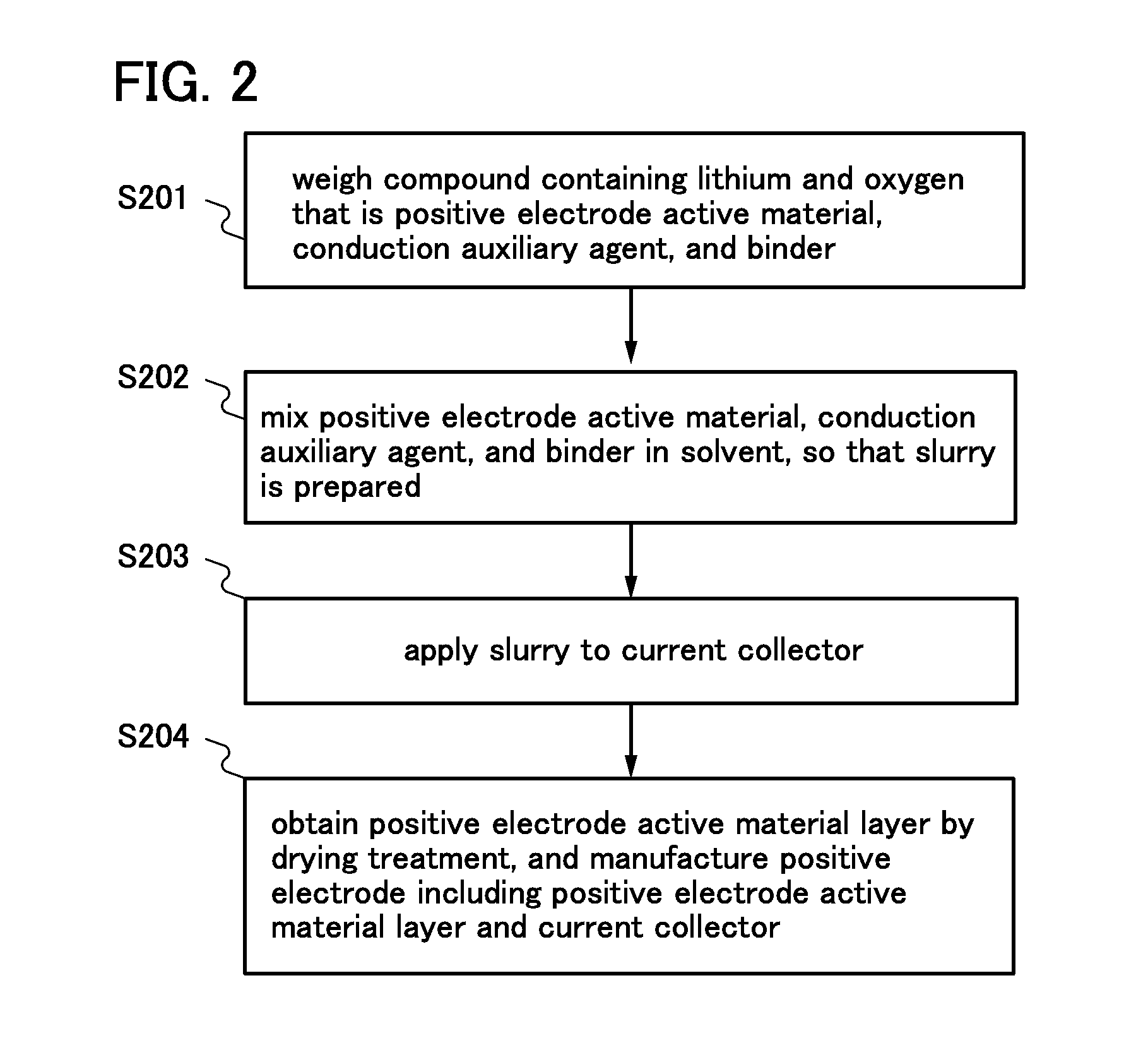Method of manufacturing positive electrode active material for lithium ion battery
a positive electrode active material and lithium ion battery technology, applied in the direction of cell components, final product manufacturing, sustainable manufacturing/processing, etc., can solve the problem of difficulty in achieving high output of lithium iron phosphate, and achieve the effect of increasing the specific surface area and increasing the productivity of lithium ion battery manufacturing
- Summary
- Abstract
- Description
- Claims
- Application Information
AI Technical Summary
Benefits of technology
Problems solved by technology
Method used
Image
Examples
embodiment 1
[0033]In this embodiment, a method of manufacturing a positive electrode active material for a lithium ion battery by hydrothermal method which is one embodiment of the present invention will be described with reference to FIG. 1.
[0034]Examples of positive electrode active materials include LiFePO4, lithium nickel phosphate (LiNiPO4), lithium cobalt phosphate (LiCoPO4), lithium manganese phosphate (LiMnPO4), Li2FeSiO4, and Li2MnSiO4.
[0035]For example, the case of manufacturing LiFePO4 which is a positive electrode active material is described. First, lithium hydroxide monohydrate (LiOH.H2O), iron(II) chloride tetrahydrate (FeCl2.4H2O), and ammonium dihydrogen phosphate (NH4H2PO4) which are source materials are weighed so that the molar ratio of LiOH.H2O to FeCl2.4H2O and NH4H2PO4 is 2:1:1 (Step S101).
[0036]Note that LiOH.H2O may be replaced with anhydrous lithium hydroxide (LiOH), lithium carbonate (Li2CO3), lithium oxide (Li2O), lithium nitrate (LiNO3), lithium dihydrogen phosphate...
embodiment 2
[0056]In this embodiment, a method of manufacturing a positive electrode of a lithium ion battery by using the compound containing lithium and oxygen which is manufactured in Embodiment 1 will be described with reference to FIG. 2.
[0057]First, the compound containing lithium and oxygen that is a positive electrode active material, a conduction auxiliary agent, and a binder are weighed (Step S201). For example, the proportions of the positive electrode active material, the conduction auxiliary agent, and the binder may range from 80 wt % to 96 wt %, from 2 wt % to 10 wt %, and from 2 wt % to 10 wt %, respectively.
[0058]Here, as the conduction auxiliary agent, a carbon-based conduction auxiliary agent such as graphene, graphene oxide, graphite, carbon fiber, carbon black, acetylene black, or VGCF (registered trademark), a metal such as copper, nickel, aluminum, or silver, or powder, fiber, or the like of a mixture thereof may be used. As the binder, a polysaccharide, a thermoplastic r...
embodiment 3
[0065]In this embodiment, a method of manufacturing a positive electrode by using the residue including the compound containing lithium and oxygen and graphene oxide which is manufactured in Embodiment 1 will be described with reference to FIG. 3.
[0066]As described in Embodiment 2, graphene and graphene oxide function as both the conduction auxiliary agent and the binder of the positive electrode active material layer. Therefore, by utilization of the residue including the compound containing lithium and oxygen, which is a positive electrode active material, and graphene oxide in Embodiment 1, a positive electrode active material layer can be manufactured without separately preparing a conduction auxiliary agent and / or a binder.
[0067]Specifically, first, a slurry in which the compound containing lithium and oxygen, which is a positive electrode active material, is mixed with graphene oxide is prepared (Step S301). Note that in the case where sufficient conductivity or the like canno...
PUM
 Login to View More
Login to View More Abstract
Description
Claims
Application Information
 Login to View More
Login to View More - R&D
- Intellectual Property
- Life Sciences
- Materials
- Tech Scout
- Unparalleled Data Quality
- Higher Quality Content
- 60% Fewer Hallucinations
Browse by: Latest US Patents, China's latest patents, Technical Efficacy Thesaurus, Application Domain, Technology Topic, Popular Technical Reports.
© 2025 PatSnap. All rights reserved.Legal|Privacy policy|Modern Slavery Act Transparency Statement|Sitemap|About US| Contact US: help@patsnap.com



